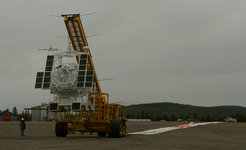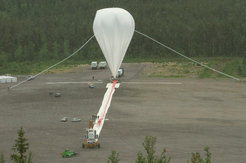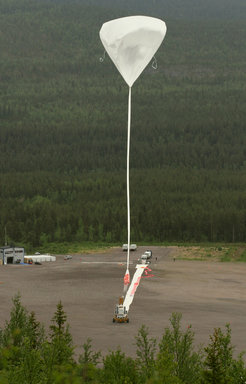Sunrise 2 successfully launched
The balloon-borne solar observatory Sunrise has lifted off - and will now begin its unique journey to the active Sun.
The balloon-borne solar observatory Sunrise has lifted off successfully from Esrange Space Center in the north of Sweden. Today at 7.37 a.m. CEST the launching vehicle released the gondola and the huge balloon lifted Sunrise into the sky. Ever since in the past week the last ground-based tests had been completed, the team has been waiting for favorable weather conditions. Last Thursday a first attempt to launch had to be aborted, because the wind had suddenly grown stronger. Polar winds will now grasp balloon and gondola and in the next days carry both westward around the North Pole in a traveling height of more than 35 kilometers. The solar observatory Sunrise carries the largest solar telescope ever to have left the Earth's surface. During the whole flight, the telescope will turn its unique gaze on the Sun.
Today around 2 a.m. CEST the huge launching vehicle picked up Sunrise from the large experimental hall, that has been harboring the solar observatory in the last two months, and brought it to the launch pad. After the empty balloon had been laid out, the weather continued to hold and mission control gave its final consent to start filling the balloon with helium. During ascent, the balloon will expand and finally reach a diameter of approximately 130 meters. Accompanied by the team's applause, Sunrise started to climb into the sky over Esrange Space Station near Kiruna in the north of Sweden at 7.37 a.m. CEST.

"The weather conditions are decisive for launching", Prof. Dr. Sami K. Solanki, the mission's scientific head and director at the MPS, explains. "Sunrise can only safely reach its travelling height, if the winds in the air layers below blow only very lightly. This is especially important on the first few kilometers". Since in a height of 35 kilometers the winds are currently quite strong, the Sunrise-team is anticipating a rather short flight time. After four or five days, the observatory could already reach the north of Canada, where it will land with the help of a parachute.

Until then, the Sunrise-team intends to use every second to turn Sunrise's unique gaze on the Sun. Apart from the telescope Sunrise carries further scientific instruments on board that will study the Sun's magnetic fields with high resolution. Scientists assume that these fields hold the key to many unsolved mysteries of solar physics. For example, it is still unclear, why the Sun's activity changes in an approximately eleven-year-cycle.
Currently, the Sun is in a state of high activity. In this phase the Sun's magnetic fields are especially dynamic and time and again the Sun hurls radiation and particles into space in violent eruptions.

Four years ago, Sunrise embarked on its first mission and was able to discern the smallest magnetic structures on the Sun's surface, the building blocks of the magnetic field. However, at that time the Sun remained in an unusually long activity minimum.
The Sunrise mission is led by the Max Planck Institute for Solar System Research in Germany. Further partners are the High Altitude Observatory (Boulder, Colorado), the Kiepenheuer Institute for Solar Physics (Germany), a Spanish consortium led by the Instituto de Astrofisica de Canarias, the Lockheed-Martin Solar and Astrophysics Laboratory (Palo Alto, California), and NASA's Columbia Scientific Ballooning Facility.


